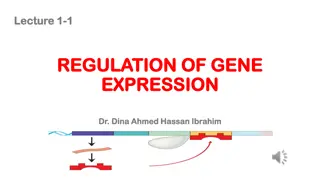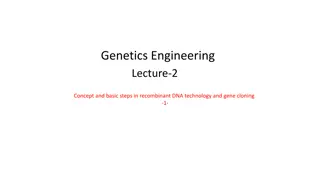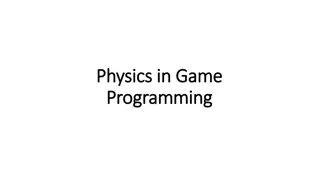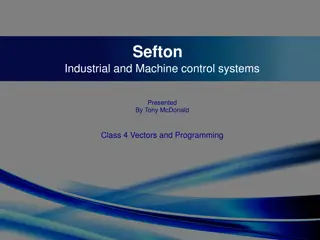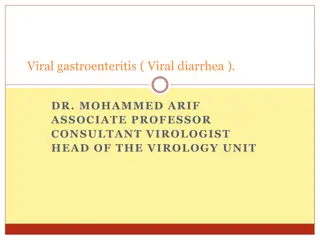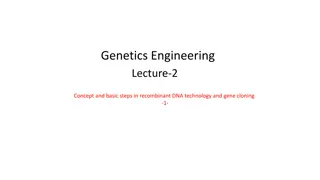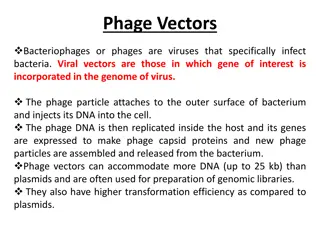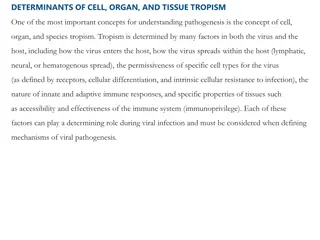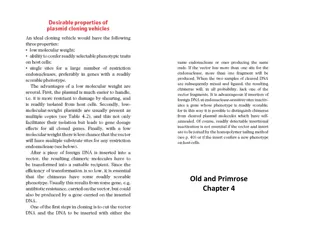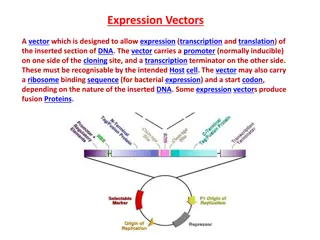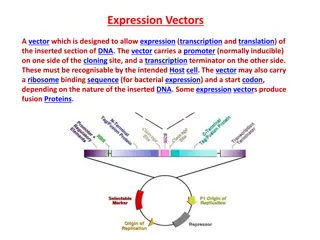Understanding Viral Vectors in Gene Delivery: Safety and Considerations
Exploring the mechanisms of gene delivery via viral vectors, this content delves into the basics of viral structure, infection, and replication. It discusses common viral vector systems like Adenoviral and Lentiviral vectors, highlighting safety considerations and the production processes involved. The importance of replication incompetence in vectors and the role of cis-acting vs. trans-acting elements are also covered, providing insights into the construction and production of viral vectors for gene therapy applications.
Download Presentation

Please find below an Image/Link to download the presentation.
The content on the website is provided AS IS for your information and personal use only. It may not be sold, licensed, or shared on other websites without obtaining consent from the author. Download presentation by click this link. If you encounter any issues during the download, it is possible that the publisher has removed the file from their server.
E N D
Presentation Transcript
Viral Vectors as Mechanisms of Gene Delivery: Safety Considerations
Objectives Why Use Viral Vectors? Basics of Viral Vectors Viral structure Viral infection and productive replication Replication incompetence in vectors Production of viral vectors Common Viral Vector Systems Adeno-associated viral vectors Adenoviral vectors Simple retroviral vectors Lentiviral vectors Summary of General Biosafety Considerations Less Common Gene Therapy Vectors
Viral Structure Non-Enveloped Enveloped Nucleic acid Nucleic acid Capsid Capsid Envelope
Basics of Viral Infection and Productive Replication Attachment Entry Uncoating Replication Assembly Release
Replication Incompetence in Vectors Typically, a viral vector will enter the cell and express the delivered gene (transgene) but will be incapable of producing new virions (replication incompetent) The ability to replicate new virions is referred to as replication competence
Production of Viral Vectors With few exceptions, genetic material is removed to render gene expression vectors replication incompetent as well as make room for insertion of gene of interest
Cis-acting vs Trans-acting Elements Cis-acting elements: Genetic elements that act on the nucleic acid that they are encoded on. Trans-acting elements: Elements whose product act on other molecules. When used as vectors, trans- acting elements can generally be removed from viral genome while cis-acting elements remain. Trans-acting elementsCis-acting elements Polymerases Promoters Capsid components Packaging signals
Production of Viral Vectors Construction of transgene cassette and packaging plasmids Transfection to packaging cell line Harvest of replication- defective vectors
Pseudotyping Surface proteins are replaced with those of another virus in order to affect host range or physical properties May be used to either broaden or narrow the host range
Common Viral Vector Systems Adeno-associated viral (AAV) vectors Adenoviral vectors Simple retroviral vectors Lentiviral vectors
Adeno-Associated Viral Vectors Adeno-associated viruses: Non-enveloped ssDNA virus Dependent upon a helper virus to replicate. Otherwise integrates into host genome until infection by helper occurs (adenovirus or herpesvirus) Considerations when used as a vector: Non-enveloped May be more resistant to alcohol-based disinfection than enveloped viruses The ability to integrate is removed from vectors Transient and helper-dependent Could potentially be rescued by coinfection Typically used in BSL1 containment
Adenoviral Vectors Adenoviruses: Non-enveloped dsDNA viruses DNA is very very rarely (0.001%) incorporated into host genome in infected cells Considerations when used as a vector: Non-enveloped Alcohol-based disinfection may be less effective than with enveloped viruses Packaged in HEK293 cells which stably express adenoviral trans-acting elements Typically used in BSL2 containment
Simple Retroviral Vectors Simple retroviruses: Enveloped ssRNA viruses RNA genome is converted to DNA and incorporated into host genome Only able to replicate in dividing cell populations Considerations when used as a vector: Enveloped alcohol disinfectants are effective Murine Leukemia Virus (MLV) is often used and pseudotyped with Vesicular Stomatitis Virus Glycoprotein (VSV-G) in order to broaden host range Typically BSL2 During risk assessment, consideration must be given to the fact that the virus incorporates into host genome
Lentiviral Vectors Complex enveloped retroviruses with ssRNA genomes Examples: HIV-1, HIV-2, feline and bovine immunodeficiency virus (FIV and BIV) RNA genome is converted to DNA and incorporated into host genome Can replicate in dividing and nondividing cell populations Considerations when used as a vector: Enveloped Alcohol disinfection is effective Can incorporate into host genome and infect nondividing cell populations Typically BSL2 or higher Generation (number of plasmids in the system) should be considered
Third Generation Lentiviral System A few versions, or generations of lentiviral packaging systems have been developed with each generation increasing in safety features Lentiviral systems should be at least third generation at UTK Fourth generation lentiviral systems exist, in which five or more plasmids are used
Biosafety Considerations for Risk Assessment What disinfectant should be used? Is the virus enveloped or non-enveloped? What risks are inherent in the wild type virus that is being used as a vector? Will genetic sequences from the virus incorporate into the host genome? What transgene and regulatory elements are being included in the vector? What elements of the viral genome are being excluded? What would be required for replication competence to re-emerge? What is the host range of the vector? Will pseudotyping occur? How might the vector behave if inadvertent exposure occurs? In research involving animal hosts, will viral shedding occur? How will the vector be handled and administered to the animal? Institutional Biosafety Committee (IBC) approval is required when working with viral vectors. Contact EHS Biosafety (utbiosafety@utk.edu or 865-974-5084) before beginning experiments involving viral vectors.
Thank you! Questions?



